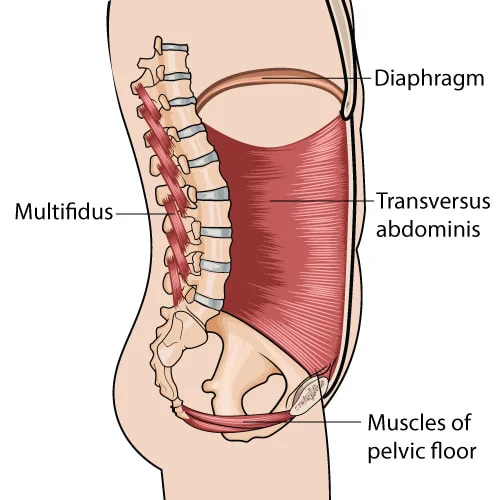Say Hello to Your Transverse Abdominis
Yesterday in my 6 pm class, I was teaching students how to use their transverse abdominis (TA) muscle. After I had spent a few minutes explaining the TA and having them feel it, I looked around my class to see one of my very pregnant students giggling. I had to laugh, as well. The use of the TA is a very different experience for an almost full-term Mama. The TA is like a corset that combines with the pelvic floor muscles, holds the baby as it grows—sort of like one of those fancy baby carriers, but on the inside. The TA is one of the essential abdominal muscles to understand because it is vital for maintaining postural stability through dynamic movement.
Wikipedia describes the attachments of the TA: "The transverse abdominal arises as fleshy fibers, from the lateral third of the inguinal ligament, from the anterior three-fourths of the inner lip of the iliac crest, from the inner surfaces of the cartilages of the lower six ribs, interdigitating with the diaphragm, and from the thoracolumbar fascia. It ends anteriorly in a broad aponeurosis (the Spigelian fascia), the lower fibers of which curve inferomedially (medially and downward), and are inserted, together with those of the internal oblique muscle, into the crest of the pubis and pectineal line, forming the inguinal conjoint tendon also called the aponeurotic falx. In layman's terms, the muscle ends in the middle line of a person's abdomen."
It is the deepest of the anterior, flat abdominal muscles, lying underneath the rectus abdominis, internal obliques, and external obliques. It is called transverse, because of the way the muscle fibers run. When activated, it creates intra-abdominal pressure. To become more familiar with its activation, try this:
1. Sit in a neutral, tall position.
2. Close your eyes and place your hands around your waist with fingertips toward the front of your belly.
3. Imagine that you are blowing out birthday candles. Forcefully exhale. Do this several times. Get a sense of the muscle that is activating to create the pressure in your belly.
4. Now do this again with a more in-depth, slower breath. Use the TA to force the very end of the exhale a bit longer. If you feel your waist getting smaller and your navel pulled in, you've got it.
The TA is often naturally activating throughout your day when you do things like sneeze, cough, or unexpectedly step off a curb. In your yoga practice, you can intentionally train your use of it through many movements to create more stability for your spine. It will also help balance out any overuse of the more superficial muscles like the external obliques and rectus abdominis.
Here are three ways to reeducate the TA on your mat. Remember that learning fine-tuned muscular control is a re-education for your tissues and your nervous system. Be patient, and give it time.
1. Stabilize the trunk in Long Lever Postures. LLP's are those postures that hold the limbs out and away from the trunk, creating added demand and force on the spine, especially if not stabilized properly. Think of poses like Spinal Balance and Warrior III. Use a subtle, forced exhalation to activate the TA while holding these poses. When done correctly, you will feel very sturdy in your trunk, and your spine will maintain a neutral position, rather than dip into backward bending.
2. In Chaturanga Dandasana, aka Low Pushup. Many of the misalignments that happen in this pose are due to the inability to stabilize the weight of the body in this horizontal relationship with gravity. This can be done from the knees or toes. As you lower into Chaturanga, activate the TA with the subtly forced exhalation. Visualize and feel the corseted strength like strong hands, holding your spine in space.
3. In Upward Facing Dog, use the TA corset in a similar manner as described in Chaturanga. Keep the activation that you began in Chat, and let it hold your torso in space as you telescope your spine into Upward Facing Dog. When activated properly, you will feel a lift from below and you won't be in a maxed-out backbend in your lumbar spine––this is the aim.
As with everything, don’t over-do it! I find that learning more about my body supports my ability to tune-in and feel more. As I tune-in to my body sensations, it allows me to give all of the other stuff a break. I lovingly nudge my mind to focus on the concrete experience of now, rather than the repetitive preoccupation with some past or future event. This is my yoga.
Keep moving with love y’all! And if you want to learn more about your body and yoga, please check out my book, Embodied Posture: Your Unique Body and Yoga. It is available in paperback and Kindle!
We are headed out next week on our West Coast tour. Dave and I will be camping, biking, and “yogaing” our way from Big Sur up to Seattle! Check out my website for details on where we will be teaching. Follow our adventures on IG at txyogastacy and txyogadave!
I will be teaching a module on The Shoulder in Bali next month and we have one spot available. In July I will be teaching The Spine in Fort Worth TX and The Hip in Thailand this September. Go here for details!



